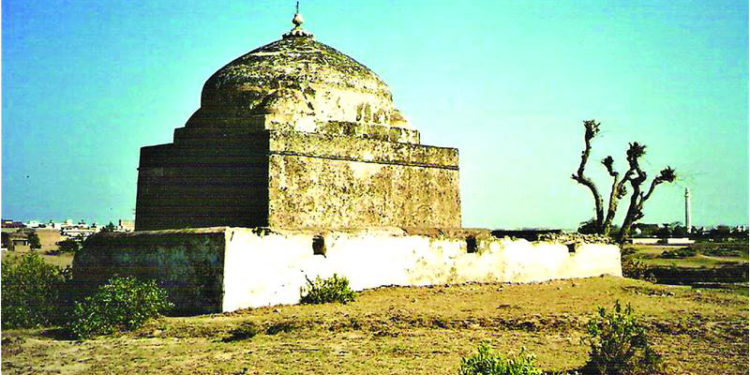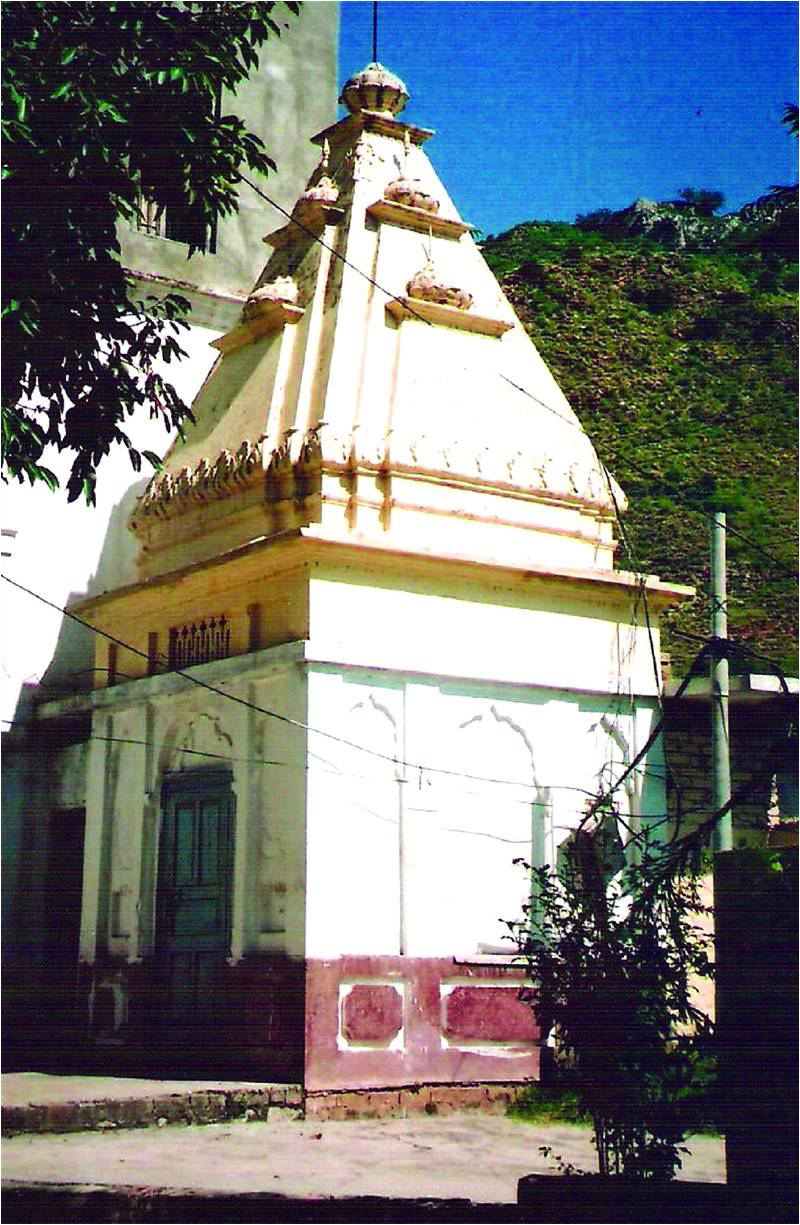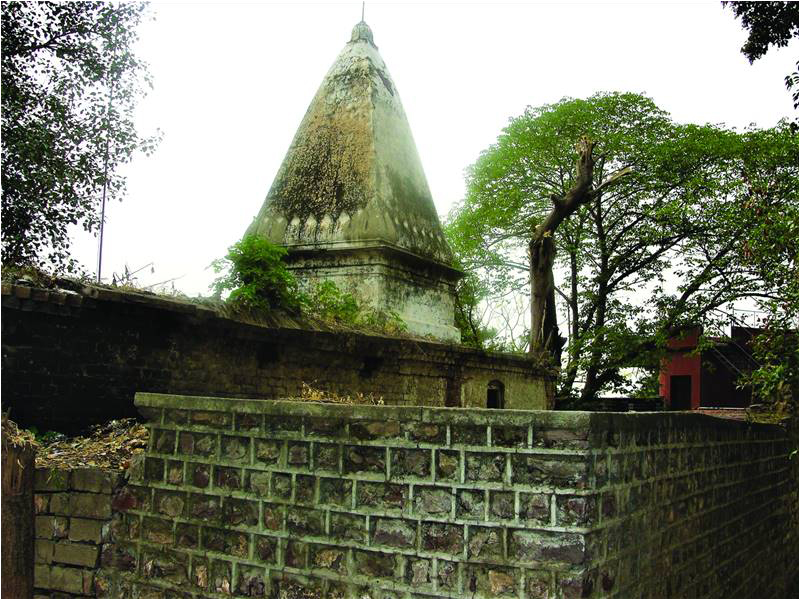
There are a number of historical buildings in the main city, of which the Rawal Lake temple, Golra temple and Saidpur Village temple complex are quite prominent.
Zulfiqar Ali Kalhoro
Those who believe Islamabad has no past ought to do some traveling in the city’s outskirts. They will not only find numerous historical buildings in this otherwise 59-year-old city to testify to its antiquity, but also discover various artifacts such as fossils in Bagh Jogian village and ancient tools used by prehistoric humans in Rawat from the Paleolithic era.
In fact, one does not necessarily have to traverse the outskirts. There are also a number of historical buildings in the main city, of which the Rawal Lake temple, Golra temple and Saidpur Village temple complex are quite prominent.
A Hindu temple stands in a dilapidated condition at Rawal Lake. Formerly, this place was known as Rawal village. It is a rectangular building with two arched openings on its south. There are five flights of steps to reach the grabhagriha (sanctum).
Rawal village was an ancient settlement as can be seen from the painted and also un-decorated potsherds lying at many places. A rock shelter, which is located at the temple’s north, also offers testimony to the fact that prehistoric human beings used this site.

Before the 1947 Partition, Hindus predominately inhabited Rawal Village. There were nearly a hundred households in the village, of which only 40 belonged to Muslims. At that time, Ishar Singh was the numbardar (head) of the village. Some Muslim castes, namely Raja (also known as Gakhars or Kiyanis), Syed, Bafanda, Thakyal Rajputs and Malhar lived in the village.
The shrine of Rama was a popular pilgrimage center for Hindus of Rawalpindi before Partition
There were two other temples in Rawal village, one on the opposite side of the existing temple. It had two rooms and eight archways that allowed one to enter the building.
The other temple, known as the Gurukal temple, was submerged in the water of the Rawal Dam.
These temples now only exist in the memories of old inhabitants living in Rawal town and other villages of Islamabad, with whom I met and conducted interviews for this article. Before Partition, a Samadhi belonging to a Hindu ascetic of the Nath Jogi order was located near the present Rawal Chowk. It was a small, domed structure where Hindu ascetics practiced rituals.
There are many other sacred places of Nath jogis, probably used for meditation, in and around Islamabad. Among these, the sacred spaces at Bagh Joghian, which means “orchard of jogis”, are quite prominent. Another place associated with jogis is located just 2 km west of Bari Imam. Jogis traveling to Taxila and other places stopped here on their way. There is also a Hindu shrine south of the Bari Imam shrine which was another Nath Jogi spiritual site, now deserted.

Today, the Rawal Lake temple lies in a poor state of preservation. The outer wall of the temple has fallen. One wonders if it’s too much to ask of the authorities to save the ancient structure from further damage.
Like the Rawal Dam temple, the condition of the Golra temple is also very dilapidated. There are two historic buildings in Golra which belong to Hindus and Sikhs. The building from the Sikh period, locally called a Sikh dharamshala, was razed to the ground while developing E-11 sector in 2002. The other building, which is the temple of Hindus, still stands – though in a crumbling condition.
A Hindu temple is located just behind the haveli of the Pir of Gorla Sharif in Islamabad. It is also adjacent to the old Bazaar of the Sikh period where there are still remains of some shops of Sikhs and Hindus.
This temple is remarkable for the foliated pillars that decorate the corners of the outer wall of the sanctum. Its main entrance opens to the east and one enters into the courtyard of the temple through this gate. Formerly, the courtyard was covered but nowadays the ceiling has caved in. The inner walls of the courtyard have three windows below which are sunken panels on northern, western and eastern sides.
The grabhagriha is preceded by three cusped archways with a trefoil. The grabhgriha is squared and the shikhara (superstructure), which surmounts the sanctum, is also square. One finds on the lower part of the shikhara a blind arch on each side. The upper part of the shikhara is, however, decorated with miniature shikharas (urusringas). The cornices of the shikhara are gently carved. The grabhagriha has there blind arches on the southern, western and northern walls. The western wall has, however, a split arch. One can find traces of paintings on these arches. Apart from the arches, there are also traces of paintings inside the temple. Formerly, the sanctum was adorned with paintings – the western and northern walls carried paintings of Hindu deities. Close to this panel was another one, which depicted Ganesh or Ganapati, the son of Lord Shiva. The ceiling of the circumambulatory passage (pradakshinapatha) was similarly decorated with paintings representing Shiva, Ganesh, Krishna and various Hindu goddesses.
The outer walls of the grabhagriha are also decorated with blind arches and the outer walls of the temple are decorated with cut-brick ornamentation.
Apart from a temple, once there was Sikh dharamsahla near Golra Sharif but it fell victim to development work. It was located some 2 km west of Golra Sharif. According to the locals, the dharamshala was destroyed by the staff of the federation society for the development of a new sector. The dharamshala was perched on a mound and did not occupy much space.
When I first visited the dharamshala in 2002, I found it in a good condition. It was built on a squared plan and crowned with dome. According to the local people, it had a carved door with peacock motifs. But, later, people took away the door. It was demolished during the development of the new housing scheme in E-11.
The façade and inside of the dharamshala were adorned with paintings depicting scenes of Sikh culture and beliefs. However, the painting of Guru Nanak with his companions Bhai Bala and Bhai Mardana was found on the western and northern walls of the dharamshala. Only the best online friv games are presented on this mega portal. Play online games on the friv games site with the whole family.
Apart from the Rawal Lake and Golra temples, the temple complex of Saidpur was also quite a popular Hindu pilgrimage place which was converted into tourist site by CDA. There were four: Ram Kund (tank), Lakshman Kund, Sita Kund and Hanuman Kund – all famous characters of the Ramayana. The shrine of Rama was a popular pilgrimage center for Hindus of Rawalpindi before Partition. There also existed a temple which housed the images of goddesses Lakshmi and Kali. Beside the temple was located a gurdwara, now turned into museum, which is believed to have been built by Sikhs in the early 20th century. All the buildings exist except the Kunds, where today Des Pardes restaurant is located. All the structures lost their original beauty when these were renovated and Saidpur village was declared a tourist village – playing havoc with the actual heritage.
_______________
 Dr. Zulfiqar Ali Kalhoro is an anthropologist and has authored 12 books: ‘Symbols in Stone: The Rock Art of Sindh’, ‘Perspectives on the art and architecture of Sindh’, ‘Memorial Stones: Tharparkar’ and ‘Archaeology, Religion and Art in Sindh’. He may be contacted at: zulfi04@hotmail.com
Dr. Zulfiqar Ali Kalhoro is an anthropologist and has authored 12 books: ‘Symbols in Stone: The Rock Art of Sindh’, ‘Perspectives on the art and architecture of Sindh’, ‘Memorial Stones: Tharparkar’ and ‘Archaeology, Religion and Art in Sindh’. He may be contacted at: zulfi04@hotmail.com
Courtesy: The Friday Times Lahore